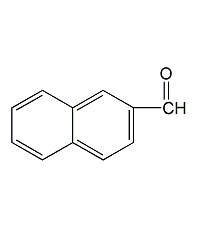
Structural formula
| Business number | 01EE |
|---|---|
| Molecular formula | C11H8O |
| Molecular weight | 156.18 |
| label |
β-naphthaldehyde, β-Naphthaldehyde, Napthtalene-2-carbaldehyde |
Numbering system
CAS number:66-99-9
MDL number:MFCD00004094
EINECS number:200-640-2
RTECS number:QJ0190010
BRN number:507750
PubChem number:24897548
Physical property data
1. Character: flake crystal
2. Density (g/mL, 25/4℃): 1.0775
3. Relative vapor density (g/mL, air =1): Uncertain
4. Melting point (ºC): 58-61
5. Boiling point (ºC, normal pressure): Uncertain
6 . Boiling point (ºC, 19mmHg): 160 (2533pa)
7. Refractive index (n99D): 1.6211
8. Flash point (ºC):>110
9. Specific rotation (º): Uncertain
10. Autoignition point or ignition Temperature (ºC): Uncertain
11. Vapor pressure (kPa, 25ºC): Uncertain
12. Saturated vapor pressure (kPa, 60ºC): Uncertain
13. Heat of combustion (KJ/mol): Uncertain
14. Critical temperature (ºC): Uncertain
15. Critical pressure (KPa): Uncertain
16. Log value of oil-water (octanol/water) partition coefficient: Uncertain
17. Explosion upper limit (%, V/V): Uncertain
18. Lower explosion limit (%, V/V): Uncertain
19. Solubility: soluble in ethanol, ether, acetone, and can evaporate with water vapor
Toxicological data
Acute toxicity: Mouse route unknown LD50: 1500 mg/kg;
Ecological data
None yet
Molecular structure data
1. Molar refractive index: 51.84
2. Molar volume (cm3/mol): 135.2
3. Isotonic specific volume (90.2K ): 356.1
4. Surface tension (dyne/cm): 48.1
5. Polarizability (10-24cm3):20.15
Compute chemical data
1. Reference value for hydrophobic parameter calculation (XlogP): None
2. Number of hydrogen bond donors: 0
3. Number of hydrogen bond acceptors: 1
4. Number of rotatable chemical bonds: 1
5. Number of tautomers: none
6. Topological molecule polar surface area 17.1
7. Number of heavy atoms: 12
8. Surface charge: 0
9. Complexity: 164
10. Number of isotope atoms: 0
11. Determine the number of atomic stereocenters: 0
12. Uncertain number of atomic stereocenters: 0
13. Determine the number of chemical bond stereocenters: 0
14. Number of uncertain chemical bond stereocenters: 0
15. Number of covalent bond units: 1
Properties and stability
1. Exist in mainstream smoke.
Storage method
This product should be stored sealed with argon gas.
Synthesis method
Pour dry hydrogen chloride into the mixture of anhydrous tin dichloride and anhydrous ether until saturated, then add2- The ether solution of naphthalenenitrile is then added with hydrogen chloride until it is saturated to form a yellow complex of aldimine and tin tetrachloride. Distill the complex with water vapor, and filter out the white solid product from the distillate, which is the crude product 2-naphthaldehyde. Distill under reduced pressure to obtain the pure product, which is collected The rate is about 70%.
Purpose
Biochemical research. Organic Synthesis.

 微信扫一扫打赏
微信扫一扫打赏

